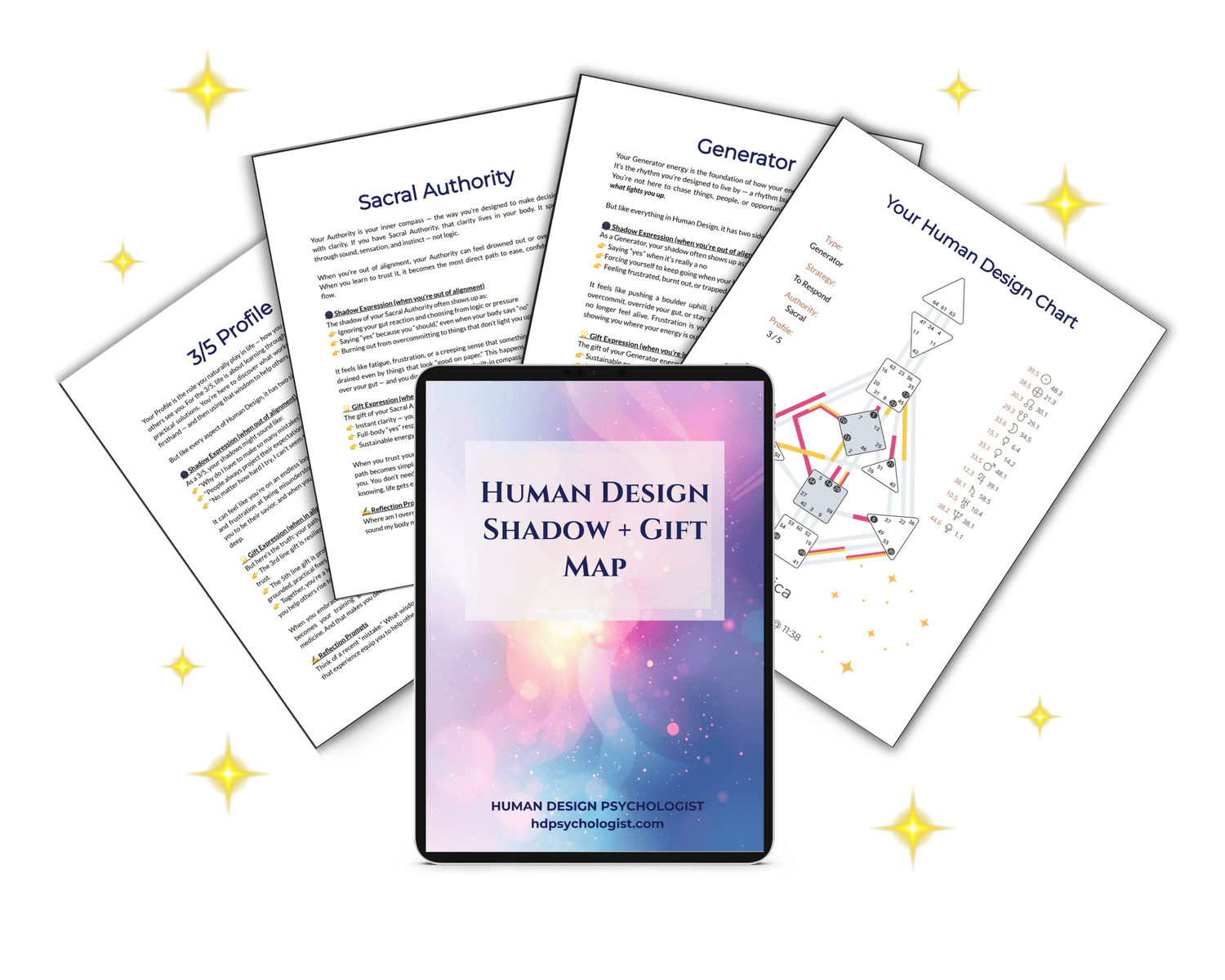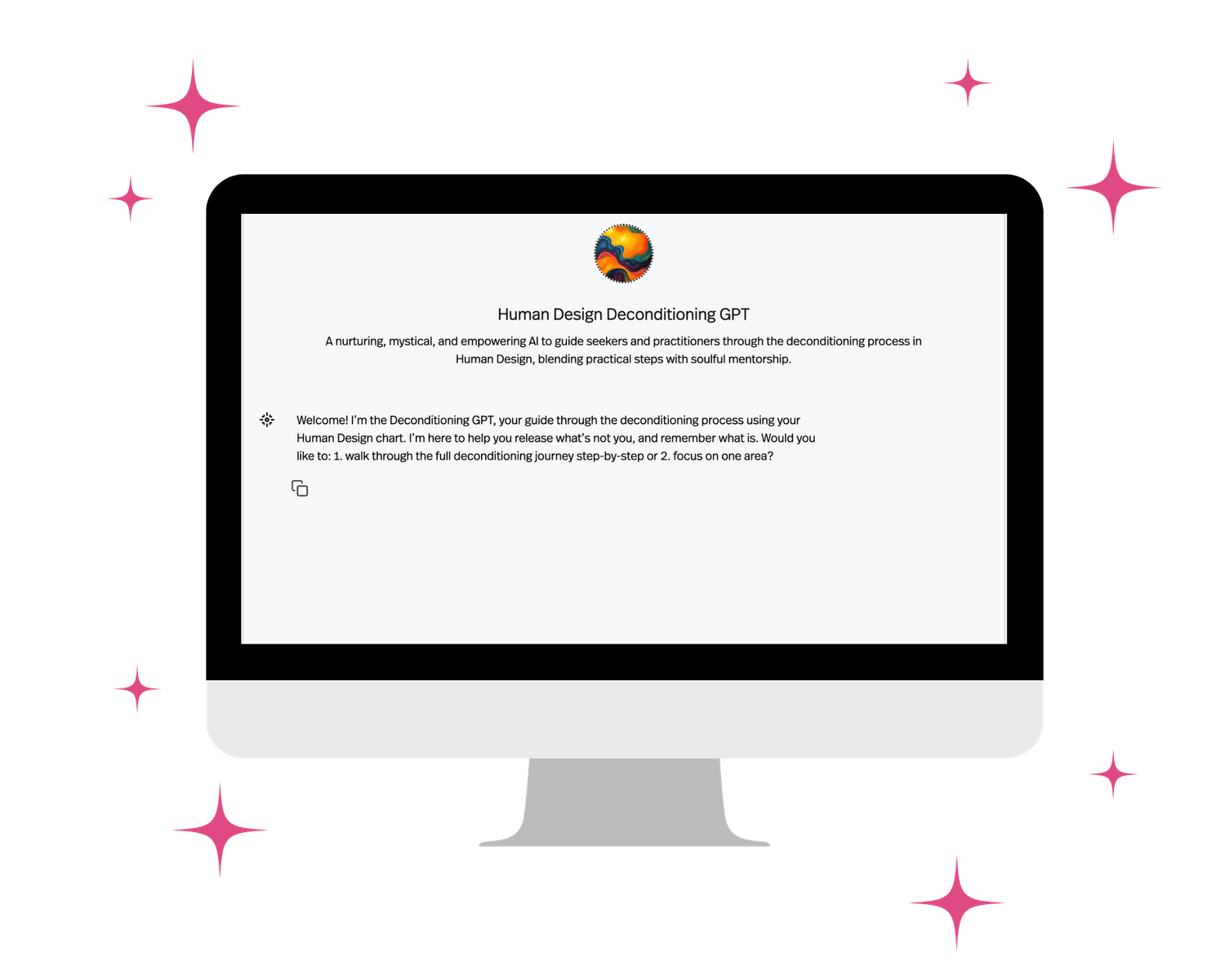Deconditioning in Human Design: What It Means, Why It Matters, and How to Begin

You’ve read about your Type. You know your Strategy. Maybe you even understand your Profile, your Centers, and a few of your Gates. And yet…something still feels off. You know what alignment is supposed to look like — but actually living it can feel slippery. You try to follow your design, but end up second-guessing every decision, forcing what should flow naturally, or doubting what your body already knows.
Here’s the truth: that’s not failure. That’s conditioning — the invisible layer of learned survival strategies, expectations, and energy patterns you’ve picked up from the world around you. It’s what makes alignment feel like a performance instead of a lived experience.
In this blog post, we’ll explore what deconditioning really means in Human Design, why it matters, and a simple deconditioning process you can follow so that you can live truer to your Human Design chart.
What Deconditioning Really Means in Human Design
In Human Design, deconditioning is the process of releasing what’s not truly yours — the energy, expectations, beliefs, and behaviors you’ve absorbed from others and mistaken as your own. It’s not about becoming someone new or fixing something that's broken about you. It’s about remembering who you were before the world told you who to be. Before you started twisting yourself to meet expectations. Before survival strategies became personality traits.
Deconditioning is meant to bring you back to your natural self — the one that already knows how to live in alignment, once the noise is stripped away.
The Mechanics Behind Deconditioning (In Simple Terms)
Every Human Design chart is made up of a living network of energy — including your Type, Authority, Centers, Channels, Gates, and your Profile, all interacting to shape how your energy moves through the world. When you begin the deconditioning process, you’re not just working with one piece of your chart — you’re learning to untangle all the ways your system has adapted to survive in a world that doesn’t always honor your uniqueness.
Your defined Centers are where your energy is consistent and self-sourced. These are your natural strengths — the places where you can rely on your own clarity and rhythm. When conditioning touches a defined center, however, it can make this energy more rigid. You might cling to what’s familiar or try to overexpress that energy to prove something.
Your open or undefined Centers are where you’re most receptive to conditioning. These are the places where you take in, amplify, and sometimes absorb energy from others. This sensitivity can be one of your greatest teachers — but when you identify too intensely with what you absorb, that borrowed energy can become the foundation of who you think you are. Over time, you might start chasing what you're not meant to chase, suppress who you really are, and confuse your conditioned reactions as the truth of who you are.
Conditioning can also weave itself through your Channels and Gates — the pathways that connect your Centers. A Channel links two Centers together, blending their themes. When one end of the Channel is open (i.e., there's a handing Gate), it can becomes especially sensitive to outside energy, carrying that influence through the connected Center. Over time, this can create energetic “habits” — patterns that feel automatic but aren’t actually aligned with your design. Gates can hold the same imprint, especially when connected to open Centers or when they’re activated by planetary transits or relationships with others.
Then, there’s your Profile — the personality layer that shows how you’re meant to move through life and connect with others. Each Profile line carries both a natural gift and a conditioned behavior that forms when you’re shamed or misunderstood for being yourself. Deconditioning allows each line to soften back into its truth — so your natural curiosity, connection, and wisdom flow naturally again.
Finally, conditioning also reveals itself through your Type and Authority — the body-based mechanisms that guide your alignment. When you ignore or mistrust them, you can enter what Human Design calls your Not-Self theme: frustration for Generators, anger for Manifestors, frustration and anger for Manifesting Generators, bitterness for Projectors, disappointment for Reflectors. Those emotions aren’t flaws; they’re feedback — gentle alarms that you’ve stepped away from the truth of who you are.
🌟 Unsure how conditioning might show up in your unique chart?
Get your FREE Human Design Shadow + Gift Map by signing up below — a personalized guide that shows how your unique energy expresses both its shadows and gifts across your Type, Strategy, and Authority. 👇

Deconditioning Is Not Deleting
One of the biggest misconceptions about deconditioning is that it means stripping yourself down — deleting parts of your identity or personality to become some “pure” version of your design. That’s not what this work is about. You’re not trying to erase who you’ve become.
You’re learning to discern which parts of you grew from truth and which grew from survival.
Deconditioning doesn’t ask you to reject your conditioning — it asks you to understand it. Every adaptation served a purpose once. It kept you safe, accepted, or successful in a world that didn’t yet know how to support your natural rhythm. The process now is simply noticing when those old strategies are running the show and gently choosing something different.
The more awareness you bring, the less effort it takes. Alignment with your Human Design chart isn’t something you're supposed to force; it unfolds naturally as you stop fighting your design. Because deconditioning isn’t about control — it’s about surrender. It’s the quiet practice of letting your body, not your mind, lead. Over time, your energy begins to reorganize itself around truth, and life starts to flow the way it was always meant to.

Why Deconditioning Matters (and Why Most People Skip It)
When most people first discover Human Design, they fall in love with the details — their Type, their Strategy, their Authority, their Profile, the Gates and Channels that make them unique. It’s fascinating, almost addictive, to learn how the system reflects you back to yourself. But somewhere along the way, that fascination can quietly turn into another form of conditioning — mental over-identification.
Instead of embodying our design, we start thinking about our design. We memorize concepts instead of living experiences. We talk about alignment more than we actually feel it. The mind loves Human Design because it puts words to what we’ve always sensed — but the experiment itself is not lived in the mind. It’s lived in the body, moment by moment, decision by decision.
That’s where most people stop — right at the edge of transformation. They have the awareness, but not yet the embodiment. The chart becomes a map that’s studied, but not walked. And this is exactly why deconditioning matters. It’s the bridge between understanding and becoming — the process that turns theory into truth.
That’s why the deconditioning process is so essential — it’s how you start translating information into integration.
Awareness Alone Isn’t Embodiment
Simply knowing the different elements of your Human Design chart doesn’t set you free. In fact, awareness of your chart can sometimes make your conditioning even louder — because now you know what alignment looks like, and you can hear every moment you slip away from it. You might understand your Strategy but still override it to please others. You might recognize your Authority but second-guess it every time your mind wants control. You might say you follow your Strategy and Authority — while subtly managing outcomes to feel safe.
That’s not failure on your part. It’s just a sign that awareness hasn’t yet dropped from your mind into your body. Awareness is the first step, but embodiment is what turns it into lived wisdom. And that’s what deconditioning is meant to create: the quiet, powerful shift from “I understand this” to “I am this.”

Why We Resist Deconditioning
Deconditioning isn’t glamorous. It doesn’t give your mind the dopamine rush of a new discovery or the instant gratification of a breakthrough. It’s slow, quiet work — the kind that unfolds in ordinary moments when no one’s watching. It asks for patience, consistency, and compassion — three things our conditioned world rarely celebrates.
We resist deconditioning because it feels like nothing’s happening at first. The mind craves progress it can measure, but the body’s transformation moves in subtler, deeper rhythms. It can feel disorienting when your old coping patterns start dissolving but the new way of being hasn’t fully landed yet. You’re in the space between — not who you were, but not yet who you’re becoming.
That’s where the real freedom lives. It’s in those quiet pauses where you start hearing your own voice again, noticing that what once triggered you now passes through more easily, feeling yourself soften more into presence instead of performance.
How Conditioning Shows Up in Everyday Life
Conditioning isn’t abstract — it lives in the small, everyday moments where you drift away from your body’s truth. You’ll feel it in those subtle tugs that pull you toward “should,” “prove,” or “please.” It hides in plain sight, woven into how you work, love, rest, and make decisions. Here are a few ways it commonly appears through the Centers:
Feeling Pressure to Rush or Catch Up
(Root Center)
The Root center governs pressure — both healthy momentum and chronic urgency. An undefined Root Center easily absorbs collective stress, mistaking other people’s deadlines for your own. That’s why you can feel hurried even when nothing’s actually pressing. Deconditioning this center means realizing pressure doesn’t equal purpose. True alignment feels spacious, even when you’re busy.
Proving Your Worth Through Effort
(Heart/Ego Center)
The undefined Ego Center learns early that love is earned through effort. You might push, achieve, and overpromise to prove you’re capable. But your value was never meant to depend on output. Deconditioning here is about remembering that self-worth is innate — you don’t have to do more to be enough.
Seeking Love or Direction Through Others
(G Center)
The undefined G Center is designed to be fluid — to sample different identities, places, and directions. But the world teaches consistency as safety, so you may cling to roles or relationships that give you a stronger sense of self. Deconditioning means trusting your natural adaptability, allowing identity and direction to shift with your environment.
Overanalyzing Everything
(Head & Ajna Centers)
The Head and Ajna Centers love certainty. When undefined, they amplify collective thoughts and opinions, creating endless loops of “What if?” and “What’s the right choice?” This overthinking can feel productive but also drains clarity. Deconditioning here isn’t about shutting down the mind — it’s about recognizing that your Authority lives in the body, not in your logical mind. You also don’t have to understand everything to move forward.
Conditioning always shows up as pressure — pressure to decide, to please, to prove, to fix, to rush. The moment you notice that pressure and make the choice to pause instead of react, that’s a moment of deconditioning.
How to Begin the Deconditioning Process
You don’t have to overhaul your life or disappear into a seven-year retreat to start deconditioning. You just need to begin — gently, consciously, and in rhythm with yourself. This process is less about doing more and more about noticing. Here’s a simple framework to begin integrating deconditioning into your daily life:
1. Anchor Into Your Type, Strategy, and Authority
Everything begins here. Your Type shows how your energy naturally interacts with the world. Your Strategy offers a path of least resistance — a way to flow with life instead of forcing it. Your Authority is how your body communicates truth.
You don’t need to memorize your entire chart; just start by making one small, body-led decision each day. Ask yourself: Am I moving from pressure, or from response to my Type, Strategy, and Authority? That one question begins the deconditioning process.
2. Spot the Conditioning Traps in Your Chart
Conditioning thrives where you’re most open. Start by looking at your undefined Centers and notice which themes feel the loudest: pressure, people-pleasing, proving, overthinking, or rushing. You’re not trying to fix these patterns — you’re just learning to see them clearly. Awareness dissolves identification. When you can witness a pattern without collapsing into it, you’re already changing the energy.
3. Create Simple, Personal Deconditioning Practices
Deconditioning doesn’t live in theory; it lives in repetition. The smallest daily actions retrain your system to feel safe in authenticity.
This could look like:
– Pausing before saying yes.
– Checking in with your Authority before scheduling your week.
– Taking one breath before replying to a message that triggers you.
The key is consistency, not complexity. You’re teaching your body that it’s safe to move differently now.
4. Embody Your True Gifts — Not Your Shadows
Every element of your Human Design chart holds both shadows and gifts. You don’t transcend the shadow; you integrate it. When you see that your overthinking (Head/Ajna) is actually a potential for clarity, or that your pressure (Root) can become healthy drive when used consciously, you stop resisting yourself.
Deconditioning is the alchemy of turning survival patterns into wisdom. Your chart isn’t here to limit you — it’s here to show you how every part of you can serve your evolution.
5. Integrate Consistently — One Choice at a Time
Awareness becomes embodiment through practice. Each time you pause instead of performing for others, rest instead of trying to prove yourself, or follow your Authority instead of your mind, you’re integrating. You don’t need big milestones to prove it’s working. Over time, you’ll simply notice that life feels quieter, clearer, and more honest.
The Seven-Year Cycle
Human Design often describes deconditioning as a seven-year cycle — roughly the time it takes for all of the cells in your body to regenerate. As your awareness deepens and your body gradually lets go of old energetic patterns, the idea is that every cell begins to realign to your authentic frequency. Think of it as a spiral, not a straight line — every turn brings you closer to your true nature.
Conclusion: Coming Home to What’s Already Yours
Deconditioning is not meant to be a race, but a rhythm — a slow, sacred homecoming to who you’ve always been beneath the noise. It’s not about reaching perfection; it’s about returning to presence. Every time you pause instead of push, rest instead of prove, or breathe before reacting, you’re unwinding years of inherited patterns. You’re teaching your body that it’s safe to lead again.
Over time, the work becomes less about effort and more about remembrance. You begin to notice your own pace, your own timing, your own truth. The external noise softens. The internal voice grows clearer. You start trusting that you don’t need to chase alignment — it naturally unfolds when you stop resisting yourself.
That’s how awareness of the elements of your Human Design chart become embodiment.
That’s how alignment stops being a concept and starts becoming the quiet, lived truth of your everyday life.
That’s how you finally come home — not to something new, but to what’s always been yours.
🌟 Want even MORE support on your deconditioning journey?
Check out The Deconditioning Companion GPT, an AI-powered companion that walks you through my own tried-and-true deconditioning process step-by-step. 👇

Hi, I'm Nicole!

🌟 I'm a psychologist, teacher, Human Design coach and educational consultant. 20+ years working with kids and adults in public and private settings and Ph.D.-trained. Lover of Christmas, the beach, and experiments. 3/5 Emotional Manifesting Generator. 🌟
GET UPDATES FROM ME
Copyright 2025 Human Design Psychologist
CONTACT
hi@hdpsychologist.com
770 Sycamore Ave., Ste. 122 #117, Vista, CA 92083
HOME | ABOUT | TERMS | PRIVACY POLICY | DISCLAIMER


